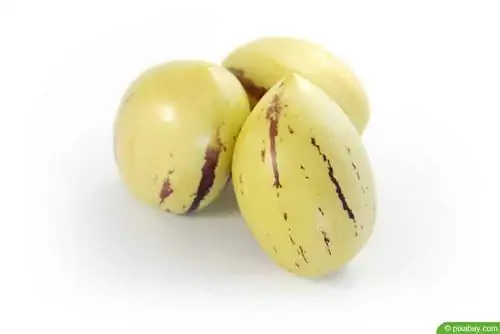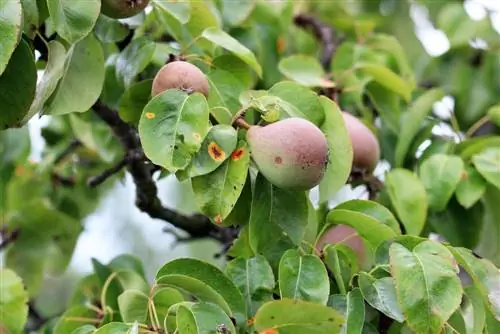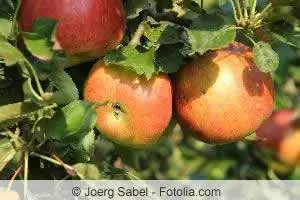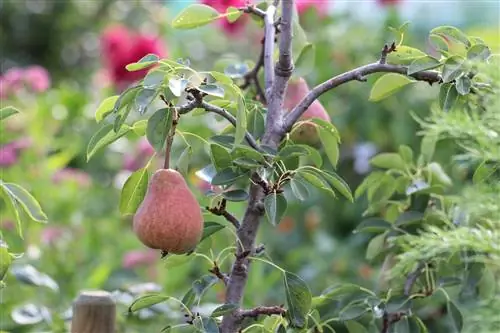- Author admin [email protected].
- Public 2023-12-17 03:39.
- Last modified 2025-01-24 12:45.
The melon pear, also known as pepino, belongs to the nightshade family. It originally comes from South America, but is now grown commercially in many countries and can also be an enrichment for the home garden. From cultivation to pruning, we provide complete care instructions from A to Z here.
Location
The pear melon, which comes from South America, needs three main factors at its location:
- Warmth
- Light or sun
- Protection
The plant cannot tolerate cold wind and frost. A sheltered location near a house wall or larger plants that can block the wind is therefore ideal. In addition, the melon pear should always be cultivated in a bucket. It is important that walls or other plants do not cast too much shade on the nightshade plant. A winter garden can also be a suitable location. However, care must be taken to ensure adequate ventilation and the possibility of fertilization if the plants are to bear fruit.
Tip:
The plant can certainly be planted outdoors, but then it is only an annual or has to be dug up before the first frost in autumn and overwintered indoors.
Freeland
Due to their sensitivity to frost, the melon pears may only be taken outdoors when frost or late frost is no longer expected. In most regions this is only the case after the Ice Saints.
Note:
The plants can be taken outside on a plant trolley or furniture trolley during the day and put back inside the house at night to protect them from frost. This is particularly useful for older and larger plants and makes work easier.
Substrate
The pear melon needs a loose and humus-rich substrate. For example, potting soil mixed with coconut fibers and an addition of well-rotted compost are well suited. Adding sand can also be useful to prevent the substrate from compacting and to make it more permeable.
In any case, it is important that drainage is also installed in the planter, because the melon pear cannot tolerate waterlogging. Suitable materials for the drainage layer at the bottom of the pot or bucket are ceramic or clay shards, coarse gravel and stones.
Planter
The size and quality of the planter should be chosen so that it offers stability and stability but is not too large. A large pot or bucket promotes root growth, but does not stimulate fruit production. It also makes sense to repot every year, choosing the planter only slightly larger than the previous one.
Pouring
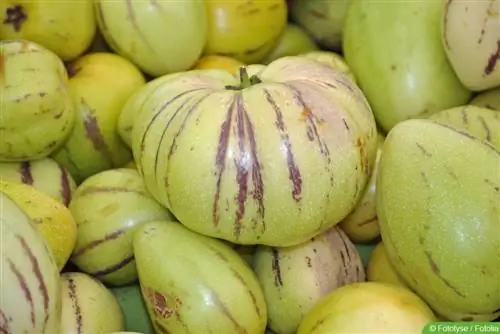
The pear melon needs a lot of water, but as mentioned, it cannot tolerate waterlogging. It can and should therefore be watered regularly and well, but always in moderation. The so-called thumb test is ideal. A thumb or other finger is pressed lightly into the surface of the substrate. If the soil feels moist or even sticks to your finger, you don't need to water it again. However, if the top layer is dry and crumbly, the plant should be watered. It is optimal to use soft, low-lime water. This means that the following sources are suitable:
- collected rainwater
- stale or soft tap water
- Pond or aquarium water
When using water from the garden pond or aquarium, care must be taken to ensure that it does not contain any potentially harmful additives.
Fertilize
If you use water from a pond or aquarium for watering, you can hold back on other fertilizers. The water contains plenty of nutrients from leftover food, plant components and faeces from aquatic creatures. Alternative fertilizers for the pear melon are:
- Complete fertilizer for fruit and vegetable plants
- well-rotted compost
- low-nitrogen fertilizers
- Plant manure, for example from nettles
During the growth phase - i.e. from around the end of May to the beginning of September - the plant can be fertilized every two weeks. After repotting or changing the soil, additional fertilizer can be dispensed with for one to two months. The prerequisite for this is of course that a nutrient-rich soil or an addition of compost is chosen.
Cutting
Pruning back the melon pear serves two purposes. On the one hand, the removal of flowerless shoots, known as thinning, can direct the plant's strength into the formation of additional flowers and shoots. Shortening all other shoots can limit the size of the plant and also promote the formation of larger fruits.
In and of itself, however, a waste is not absolutely necessary. Nevertheless, it makes sense. Controlling the size and girth and directing the effort are two key reasons for this. Another factor that speaks in favor of the blend is maintaining the he alth of the Pepino plant. Removing damaged or dead shoots reduces the risk of disease and parasite infestation. However, some factors should be taken into account. These points are:
- Use clean cutting tools, ideally the blades should be disinfected
- choose dry weather for the blend
- For larger offcuts, apply charcoal ash to the cut surfaces to achieve quick sealing and rapid drying
Propagate
Two options can be used to propagate the pear melon. On the one hand, propagation via seeds from the fruits. On the other hand, propagation via cuttings. Propagating from seeds requires a little more patience, but is otherwise quite easy. Propagation via cuttings is more complex, but requires less time.
- For propagation using seeds, the seeds can be obtained directly from the fruit or purchased from specialist retailers.
- The seeds are placed in potting soil and only lightly covered with substrate.
- The planters are placed in a warm and bright place and the soil is kept moist. Temperatures around 20 °C are ideal. The first germs should appear after two to three weeks.
- When the plants have reached a height of around ten centimeters, they can be moved to the more nutrient-rich substrate described above.
Cuttings
If propagation via cuttings is chosen, the procedure is as follows:
- Shoots about ten centimeters long are cut off from the mother plant. For this you must urgently use a knife or scissors with clean and very sharp blades.
- The shoots are inserted approximately four centimeters deep into a suitable substrate. For example, sand or potting soil are suitable.
- The substrate is well moistened, but should not be waterlogged. As an alternative to the moist substrate, the cuttings can also be placed directly in water.
- The substrate is checked daily and watered if necessary. If the substrate has been omitted, it should be changed every two to three days. Otherwise the water could become slurry and propagation would not work.
- The planter or glass is then placed in a bright and warm place.
- After about three weeks, enough roots should have formed that the young cuttings can be planted in soil.
Harvest
When the fruits of Solanum muricatum can be harvested depends on the variety. The popular Sugar Gold bears ripe fruit from around late summer, which can be eaten with the peel on. The harvest season extends until autumn. The last fruits should be harvested in the winter quarters so that the plant is not damaged by frost.
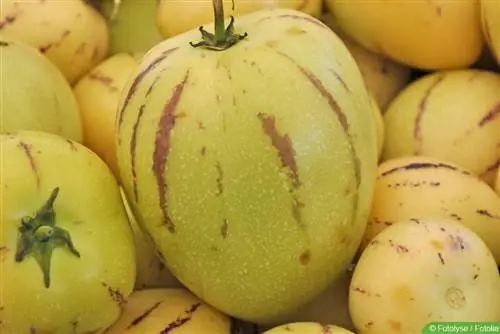
In addition to the variety, the weather and preparation are also crucial. A Pepino grown indoors, which receives a lot of light and heat in the summer and is protected and provided with sufficient water and fertilizer, can bear ripe fruit earlier in the summer. It is also beneficial if care includes cutting the budless or flowerless shoots so that more energy is available to produce the fruit. The fruits can be removed or cut off by hand. Ripeness can be recognized by the fact that the melon pears give off a fruity smell and give way slightly when pressed.
Repotting
The melon pear should be repotted once a year to provide it with fresh substrate and, if necessary, more space. An ideal time for care measures is the transition from the winter quarters to the outdoors. However, special features do not need to be taken into account. The pear melon is simply treated as follows:
- The plant is removed from the pot and from the soil.
- The old substrate should be removed as much as possible. You can either use a brush or rinse the soil away.
- If necessary, damaged or dead roots can be removed.
- If necessary, a new, larger pot can be used. In any case, new substrate should be used. In addition, drainage in the bucket should not be forgotten.
In the initial period after repotting, additional fertilization can be dispensed with as the fresh substrate provides sufficient nutrients.
Wintering
Overwintering the melon pear is very easy, all you need is a suitable space. Before the first frost in autumn, the plant is brought indoors. It should be in a room where the temperature is between five and ten degrees. The room should also be as bright as possible. A bright basement or the stairwell may be suitable.
If you don't have such space available, you can also let the plant overwinter in a nursery. Fertilization is stopped and only enough is watered so that the substrate does not dry out. The amount of water will not be increased again until spring.
Tip:
If there are still fruits on the plant in autumn, they will continue to ripen during the winter. They can therefore be harvested when they are ripe and remain on the plant for as long as possible.
Care errors, diseases and parasites
As a nightshade plant, pear melon can suffer from the same diseases and pests as tomatoes and potatoes. In addition, care errors can also cause problems for the plants. The harmful and debilitating influences include, among others:
- Fertilizers with too high a nitrogen content stimulate leaf growth, but can have a negative effect on fruit production
- Potato beetles eating the leaves
- Potato powdery mildew, which can lead to a general weakening of the plant and manifests itself as deposits on the leaves and shoots
- Lice that can cause discolored spots
- Snails that eat the shoots and leaves, especially on young plants
- Waterlogging, which can cause rot
- Tomato bronze spot virus, which can cause plant death
Checking the culture conditions and care should be the first step in any damage. When it comes to pests, home remedies can be enough to combat them. In case of illnesses, home remedies or special products from the trade can be used.
Suitable varieties
A particularly suitable variety of melon pear is the already mentioned Sugar gold. The plants grow to a height of around one meter, are self-fertile and even the peel of the fruit can be eaten. With optimal care conditions and a suitable location, it can bear fruit from summer to autumn.

